Monthly Archives: September 2016
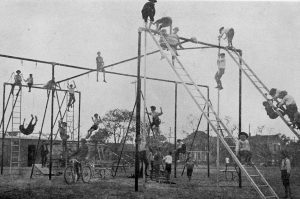
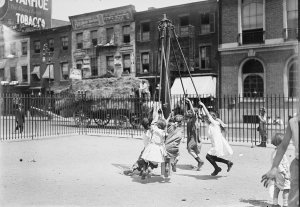 If children today were to see the playground equipment of yesteryear, I wonder if they would want to play on it, thinking it looked intriguing, or if they would simply walk away, saying that it looked boring. I suppose that to them, it probably would be boring. There weren’t any bright colored, shiny things to play on back then, and no mazes to crawl through in search of the prize…the slide at the end. I don’t know if I think that todays playground equipment is better, or worse. Or maybe, it’s just different…more advanced and inventive. I suppose that the playground equipment of earlier years required the child to be more inventive, where today’s maybe doesn’t.
If children today were to see the playground equipment of yesteryear, I wonder if they would want to play on it, thinking it looked intriguing, or if they would simply walk away, saying that it looked boring. I suppose that to them, it probably would be boring. There weren’t any bright colored, shiny things to play on back then, and no mazes to crawl through in search of the prize…the slide at the end. I don’t know if I think that todays playground equipment is better, or worse. Or maybe, it’s just different…more advanced and inventive. I suppose that the playground equipment of earlier years required the child to be more inventive, where today’s maybe doesn’t.
In the 1900s, there were often pipe built structures without paint…not that it seemed to matter to the kids. People have looked back on that equipment and wondered if it was even safe. Well, probably it wasn’t, but when you look at some of the modern day equipment, you wonder the same thing. Kids have been climbing on structures for as long as there have been kids. It’s what they do. If they have nothing to climb on or jump on, they will just jump on the bed. Now tell me you didn’t. I don’t know of one physically capable person who can honestly say they didn’t jump on the bed. In the 1900s, ladders were used to get the kids to the top of the tall structures. I’m sure that was part of the concern, but the rock climbing addition of today, isn’t really any safer, and kids will climb up the outside of a structure whether there is a proper way to get to the top or not. Remember, there isn’t a child alive who hasn’t thought at one point or another, that they were invincible.
Modern playground equipment is often designed as a “fitness” tool. That wasn’t really necessary in years gone by, because there really was no such thing as a “couch potato” then. Kids didn’t have hand held electronic gaming devises to occupy so much of their time, so they went outside and played games. I remember running around the yard until dark, once my homework was done anyway. We never sat still…and that was at home. All we had there was a swing set. The rest was make believe. The school had swings, a slide, and the monkey bars, as 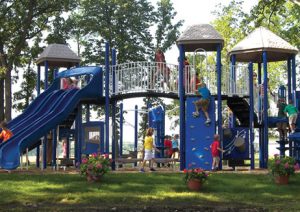
 well as tetherball poles, but no ball if school was out. Still, the school was the place to play…especially in the summer, when playing there didn’t require class time too. While the tall structure with ladders of the 1900s, or even the pole swing of 1910, looked dangerous, my guess would be that there were no more injuries on it than any other type of playground equipment…but, I could be wrong. The way I see it…kids just aren’t notoriously careful.
well as tetherball poles, but no ball if school was out. Still, the school was the place to play…especially in the summer, when playing there didn’t require class time too. While the tall structure with ladders of the 1900s, or even the pole swing of 1910, looked dangerous, my guess would be that there were no more injuries on it than any other type of playground equipment…but, I could be wrong. The way I see it…kids just aren’t notoriously careful.

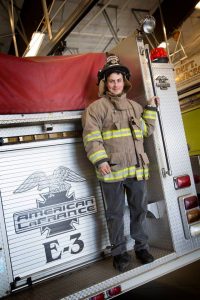 My youngest grandchild, Josh Petersen has a plan for his life. He decided a couple of years ago that he wanted to be a firefighter and EMT, and he began taking college classes through the Boces program, that allows high school students to take college classes while still in high school. Josh had been interested in becoming a fire fighter, but that interest became his dream after his grandpa, Bob Schulenberg arranged a visit to the Casper Fire Station 3. The fire fighters not only showed him around, but explained how things worked. Then they suggested that he take Fire Science at Casper College while he was still in high school. I don’t think he had any idea that he could take that kind of a class while still in high school, but he was excited…and hooked. Now, it’s all he thinks about. He loved the Fire Science class, and has continued to take college classes with his full focus on becoming a firefighter and EMT.
My youngest grandchild, Josh Petersen has a plan for his life. He decided a couple of years ago that he wanted to be a firefighter and EMT, and he began taking college classes through the Boces program, that allows high school students to take college classes while still in high school. Josh had been interested in becoming a fire fighter, but that interest became his dream after his grandpa, Bob Schulenberg arranged a visit to the Casper Fire Station 3. The fire fighters not only showed him around, but explained how things worked. Then they suggested that he take Fire Science at Casper College while he was still in high school. I don’t think he had any idea that he could take that kind of a class while still in high school, but he was excited…and hooked. Now, it’s all he thinks about. He loved the Fire Science class, and has continued to take college classes with his full focus on becoming a firefighter and EMT.
As part of the Fire Science program, Josh was required to volunteer as several events. Josh changed so much when he started these events and the Fire Science program. He was completely in his element. It was like watching him become a fire fighter…right before our very eyes. Josh thrived on the volunteer work too, so much so, in fact that this year, even though in isn’t in the class that requires him to volunteer, Josh went to that instructor, and told him he wanted to volunteer. His instructor was shocked. I guess no one had ever asked to do it again, but you just don’t turn a volunteer away, so Josh is volunteering again this year. He will 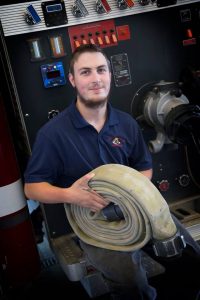
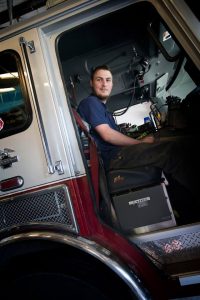 be helping at three events, a 5K run, the Platte River cleanup, and the Fire Station 3 open house. He is so excited to be back helping the fire fighters do the things they do…even if these things aren’t fire related this time.
be helping at three events, a 5K run, the Platte River cleanup, and the Fire Station 3 open house. He is so excited to be back helping the fire fighters do the things they do…even if these things aren’t fire related this time.
Josh loves everything fire fighter related…so much so, that he decided that he wanted some of his senior pictures taken at the fire station. So, his grandpa called to make that arrangement too. Josh had such a good time having those pictures taken. It was like he could see into the future. He saw himself as a fire fighter…like it had already happened. Soon Josh…before you know it. Today is Josh’s 18th birthday. Happy birthday Josh!! Have a great day!! We love you!!
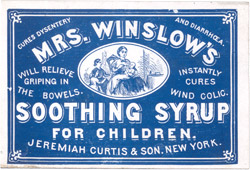 For as long as babies have been getting teeth, parents have been dealing with cranky babies. People have tried everything from a cold washcloth to alcohol. These days, there are other safe products that can be used, such as baby Tylenol, Motrin, or Ibuprofen, not to mention things like Numbs It. In years gone by, however, things were different. There were no real controls on medicines like there is today, and they didn’t know what ingredients could be harmful, or what might interact with other ingredients to cause serious problems.
For as long as babies have been getting teeth, parents have been dealing with cranky babies. People have tried everything from a cold washcloth to alcohol. These days, there are other safe products that can be used, such as baby Tylenol, Motrin, or Ibuprofen, not to mention things like Numbs It. In years gone by, however, things were different. There were no real controls on medicines like there is today, and they didn’t know what ingredients could be harmful, or what might interact with other ingredients to cause serious problems.
Inventors, and sometimes even housewives, came up with remedies that worked to ease the pain, and assumed that they had found the solution. Little did they know what problems they were causing down the road. Remedies like Doctor John’s Elixir, or some other such name, made by people with no training as a doctor, nurse, or even a pharmacist, and no control to 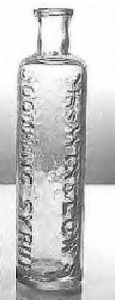 make sure they are safe. These formulas were often called “patent medicines” because they were over the counter medicines that were not patented, but were trademarked. One of the most famous was Mrs Winslow’s Soothing Syrup. In 1845, druggists Jeremiah Curtis and Benjamin A. Perkins, of Bangor, Maine, partnered to manufacture this remedy. It was said that Mrs Charlotte N Winslow, Curtis’ mother-in-law, created the formula while she was a nurse caring for infants. According to the label, the syrup could take away “teething pain, regulate the bowels, and was the best known remedy for dysentery and diarrhoea, whether arising from teething or other causes.”
make sure they are safe. These formulas were often called “patent medicines” because they were over the counter medicines that were not patented, but were trademarked. One of the most famous was Mrs Winslow’s Soothing Syrup. In 1845, druggists Jeremiah Curtis and Benjamin A. Perkins, of Bangor, Maine, partnered to manufacture this remedy. It was said that Mrs Charlotte N Winslow, Curtis’ mother-in-law, created the formula while she was a nurse caring for infants. According to the label, the syrup could take away “teething pain, regulate the bowels, and was the best known remedy for dysentery and diarrhoea, whether arising from teething or other causes.”
It all sounds wonderful…the perfect solution to all the baby’s ills, right? Wrong!! The two main ingredients were morphine and alcohol. Yes, it got rid of the pain, and pain medications cause constipation, so that took care of the other issues, but morphine is addictive at best, and deadly at worst, especially if the patient is given too much…which was a distinct possibility, given the fact that no one knew that morphine was addictive or deadly. Then add to it, alcohol…which shouldn’t be mixed with morphine, and you have a seriously dangerous drug. It’s not known exactly how many children became addicts and how many died, but it was used everywhere until it was denounced as dangerous in 1911 and even then, they still sold it until about 1930. Of course, medicines of today can be found to be dangerous, but much of the time, the medicines are tested for quite a while before they are released, and then most by prescription only…at least at first.
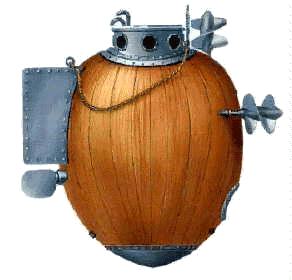 When most of us think of submarines, we think of the modern day nuclear subs that are basically underwater mobile cities, but as we all know, submarines have been around a lot longer…just how long was a surprise to me, although a learned history buff might not have been shocked at all. The idea of being able to operate underwater, actually dates back to ancient times when people used a hollow stick to breathe underwater. I’m not sure how successful any of those early attempts were, especially in the use of a vehicle of some kind, but probably not successful enough to warrant any kind of mass production.
When most of us think of submarines, we think of the modern day nuclear subs that are basically underwater mobile cities, but as we all know, submarines have been around a lot longer…just how long was a surprise to me, although a learned history buff might not have been shocked at all. The idea of being able to operate underwater, actually dates back to ancient times when people used a hollow stick to breathe underwater. I’m not sure how successful any of those early attempts were, especially in the use of a vehicle of some kind, but probably not successful enough to warrant any kind of mass production.
The first documented record of a submarine being used in combat, came as quite a surprise to me. The submarine, named Turtle, but usually called American Turtle, was used during the American Revolutionary War in 1776. Turtle was built in Old Saybrook, Connecticut in 1775 by American, David Bushnell as a means of attaching explosive charges to ships in a harbor. Turtle was designed 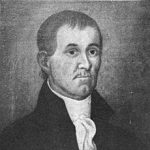 for use against British Royal Navy vessels occupying North American harbors. Then Connecticut governor, Jonathan Trumbull recommended the invention to George Washington. Even though Washington had his doubts, he provided funds and support for the submarine’s development and testing.
for use against British Royal Navy vessels occupying North American harbors. Then Connecticut governor, Jonathan Trumbull recommended the invention to George Washington. Even though Washington had his doubts, he provided funds and support for the submarine’s development and testing.
By 1776, Turtle was ready for testing. Several attempts were made by submarine operator, Sergeant Ezra Lee to affix explosives to the undersides of British warship HMS Eagle on September 7, 1776 in New York Harbor. Unfortunately, all of them failed, and Turtle’s transport ship was sunk later that year by the British…with Turtle aboard. Bushnell claimed to have recovered Turtle, but that has not been proven. Replicas of Turtle have been built and they are on display at the Connecticut River Museum, the U.S. Navy’s Submarine Force Library and Museum, the Royal Navy Submarine Museum and the 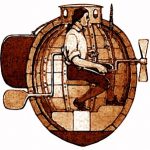 Oceanographic Museum in Monaco.
Oceanographic Museum in Monaco.
While Turtle was not successful, it was innovative, and it inspired other inventors to come up with ways that a submarine could be successful in combat, as well as exploration. I have to wonder if David Bushnell, or any of the other early inventors of crafts that operated under water had any idea how far below the surface of the oceans the submarine would eventually be able to go. Think of all the ships and planes that would never have been located, if we had no way to peer beneath the surface, and how much cargo would never have been recovered if we could not travel far below to not only locate, but salvage the cargo lost at sea. The submarine is truly amazing.
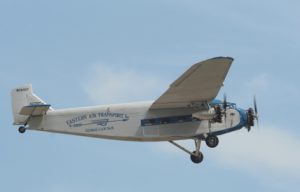 In the early history of airplanes, they were used for things like mail. No one had really considered other uses, or if they did, the idea was far in the future in the minds of most people. Nevertheless, there was one man…William Bushnell Stout, who was an aeronautical engineer. William had previously designed several aircraft using principles similar to, and originally devised by Professor Hugo Junkers, the noted German all-metal aircraft design pioneer. Junkers was one of the mainstays of the German aircraft industry in the years between World War I and World War II. In particular his multi-engined all-metal passenger and freight planes helped establish airlines in Germany as well as all over the world. Stout designed planes using the same principles as Junkers had, but they were pretty much on paper. Then in the early 1920s, Ford Motor Company Henry Ford, along with a group of 19 other investors including his son Edsel, invested in the Stout Metal Airplane Company. Stout, a bold and imaginative salesman, sent a mimeographed form letter to leading manufacturers, asking for $1,000 and telling them, “For your one thousand dollars you will get one definite promise: You will never get your money back.” Stout raised $20,000, including $1,000 each from Edsel and Henry Ford. It’s hard for me to imagine that he would get even one investor, but I guess they figured he was, if nothing else, truthful.
In the early history of airplanes, they were used for things like mail. No one had really considered other uses, or if they did, the idea was far in the future in the minds of most people. Nevertheless, there was one man…William Bushnell Stout, who was an aeronautical engineer. William had previously designed several aircraft using principles similar to, and originally devised by Professor Hugo Junkers, the noted German all-metal aircraft design pioneer. Junkers was one of the mainstays of the German aircraft industry in the years between World War I and World War II. In particular his multi-engined all-metal passenger and freight planes helped establish airlines in Germany as well as all over the world. Stout designed planes using the same principles as Junkers had, but they were pretty much on paper. Then in the early 1920s, Ford Motor Company Henry Ford, along with a group of 19 other investors including his son Edsel, invested in the Stout Metal Airplane Company. Stout, a bold and imaginative salesman, sent a mimeographed form letter to leading manufacturers, asking for $1,000 and telling them, “For your one thousand dollars you will get one definite promise: You will never get your money back.” Stout raised $20,000, including $1,000 each from Edsel and Henry Ford. It’s hard for me to imagine that he would get even one investor, but I guess they figured he was, if nothing else, truthful.
The Ford Motor Company produced the Ford Trimotor in 1927. It was one of the first all-metal airplanes. It was often called the “Tin Goose” or “Flying Washboard.” It was the first plane that was designed to carry passengers rather than mail. Now, I don’t know about you, but the idea of flying in something called the Tin Goose or Flying Washboard, would not bring with it a feeling of confidence in the machine that was suppose to get me to my destination. I have to wonder how many people they were able to get to fly in the plane in those years. The plane was designed to carry twelve people and had three engines. The three engines allowed the plane to fly higher and faster than other airplanes or that time period. The plane could reach speeds of 130 miles per hour. The Ford 4-AT-15 Trimotor monoplane, which was piloted by Berndt Balehen, was first used in the first flight over the South Pole in November if 1929.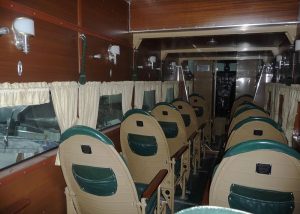
The interior of the plane was much like the interior of a passenger car on a train. Like most of the seats of any moving vehicle, design as come a long way, both in comfort and in safety, but at that time, it was state of the art. Now planes like this are a novelty item, that people go to see, because it is something they have never seen before, and may never see again. These days, the Tin Goose flies around the country being that novelty item. Recently it came to Casper, and I really wish I had been able to go see it and take a ride…maybe next time. It would be cool to fly in a Flying Washboard or a Tin Goose.
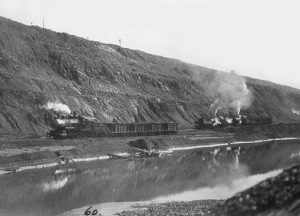 Over the centuries, metals or the discovery of metals have been something that has created everything from excitement to violence. Probably the best known discovery was that of gold, and while it is very valuable, there are many other very important metals, like iron, for instance. Very seldom do we think about all the things that are made with iron, and what an inexpensive, yet versatile metal it is. Iron is one of the most abundant metals found on earth, making up close to five percent of its crust. These iron minerals are typically mixed with clay, sand, rock or gravel. Iron is so common that it may be found in your backyard. Nevertheless, it is only mined commercially when the concentration is large enough to make it worth going after. Iron is used in cookware, fencing, vehicles, motors, buildings, and steel, just to name a few. And, every American born will need 27,416 pounds of iron in their lifetime.
Over the centuries, metals or the discovery of metals have been something that has created everything from excitement to violence. Probably the best known discovery was that of gold, and while it is very valuable, there are many other very important metals, like iron, for instance. Very seldom do we think about all the things that are made with iron, and what an inexpensive, yet versatile metal it is. Iron is one of the most abundant metals found on earth, making up close to five percent of its crust. These iron minerals are typically mixed with clay, sand, rock or gravel. Iron is so common that it may be found in your backyard. Nevertheless, it is only mined commercially when the concentration is large enough to make it worth going after. Iron is used in cookware, fencing, vehicles, motors, buildings, and steel, just to name a few. And, every American born will need 27,416 pounds of iron in their lifetime.
On this day September 5, 1844, iron ore was discovered in Minnesota’s Mesabi Range. The discovery was made 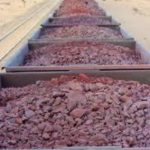 while the miners were on their way to prospect for gold. Because gold was the metal everyone was excited about, the iron ore was virtually ignored. As metals go, the iron would become far more valuable in northern Minnesota than gold. In fact, for the past 50 years, Lake Superior iron ore accounts for 90% of United States iron ore production, with much of that ore coming from the Mesabi Range, where that first discovery occurred back in 1844. Iron ore makes up the majority of Lake Superior shipping, and would soon become the most lucrative occupation in the Lake Superior shipping industry. Just imagine if you were one of those men who walked away from the iron ore discovery, in search of gold, which most never found. Wouldn’t you be kicking yourself now? There were millions to be made in the iron industry.
while the miners were on their way to prospect for gold. Because gold was the metal everyone was excited about, the iron ore was virtually ignored. As metals go, the iron would become far more valuable in northern Minnesota than gold. In fact, for the past 50 years, Lake Superior iron ore accounts for 90% of United States iron ore production, with much of that ore coming from the Mesabi Range, where that first discovery occurred back in 1844. Iron ore makes up the majority of Lake Superior shipping, and would soon become the most lucrative occupation in the Lake Superior shipping industry. Just imagine if you were one of those men who walked away from the iron ore discovery, in search of gold, which most never found. Wouldn’t you be kicking yourself now? There were millions to be made in the iron industry.
Shipping on Lake Superior is dominated by iron ore cargo. Of course, that is not the only thing shipped, but the 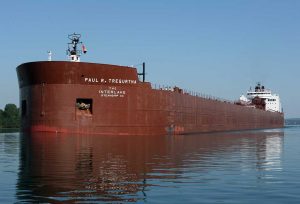 iron ore ships, which are always called ore boats, are among the most amazing in my book. The largest ore boat, the Paul R. Tregurtha is the reigning “Queen of the Lakes” title holder as the longest vessel on the Great Lakes at 1,013 feet 6 inches was constructed in two sections. When my mom, Collene Spencer, my sister, Cheryl Masterson, and I were in Superior three years ago, we got to see this amazing vessel as it left port. Of all the ships on Lake Superior, the ore boats are the ones most people think of when they think of ships on the lake. For people who make their living on the lake, the ore boats are their bread and butter. And to think it all started with a discovery that no one seemed to care about. In the end, it was an unexpected gold mine.
iron ore ships, which are always called ore boats, are among the most amazing in my book. The largest ore boat, the Paul R. Tregurtha is the reigning “Queen of the Lakes” title holder as the longest vessel on the Great Lakes at 1,013 feet 6 inches was constructed in two sections. When my mom, Collene Spencer, my sister, Cheryl Masterson, and I were in Superior three years ago, we got to see this amazing vessel as it left port. Of all the ships on Lake Superior, the ore boats are the ones most people think of when they think of ships on the lake. For people who make their living on the lake, the ore boats are their bread and butter. And to think it all started with a discovery that no one seemed to care about. In the end, it was an unexpected gold mine.
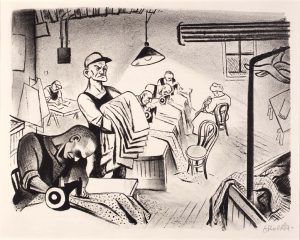 In a day and age when we see protests so often that we often pay very little attention, it’s easy to think that the protestors are just being ridiculous, and sometimes they are. That makes it easy to overlook the situations that really should be protested, or at least greeted with outrage. I suppose that every issue that is protested has its outrage, and sometimes the only way to get the attention an issue needs is to walk out and protest. Sometimes protests are simply the last resort.
In a day and age when we see protests so often that we often pay very little attention, it’s easy to think that the protestors are just being ridiculous, and sometimes they are. That makes it easy to overlook the situations that really should be protested, or at least greeted with outrage. I suppose that every issue that is protested has its outrage, and sometimes the only way to get the attention an issue needs is to walk out and protest. Sometimes protests are simply the last resort.
On this day, September 4, 1894, 12,000 tailors embarked on a strike to fight against the “sweatshop” system that exploited their labor. The tailors demanded that they be given a 10 hour work day, with an hour off for lunch. They wanted a weekly minimum wage and a weekly pay day. The “Protective Association” of cloakmaker manufacturers as well as important clothing dealers, “declared that they considered the demands of the men right, that no business which could not pay the workers the minimum wages asked ought to exist,” while “the 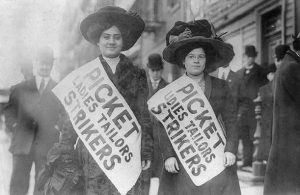 press and the public have also heartily sustained these demands, so that there can be no doubt that the public will pay, if necessary, the increased prices for the clothing rendered necessary.” While all that sounded good, the strike would continue through much of the fall. The striking workers said that the had to live half a year on what they could save out of the meager $4 per week they earned during the other half of the year. The year 1894 was a year of economic depression and widespread labor unrest. The strikes included the Pullman Strike, which paralyzed the railroads, and made Eugene Victor Debs America’s most important labor leader.
press and the public have also heartily sustained these demands, so that there can be no doubt that the public will pay, if necessary, the increased prices for the clothing rendered necessary.” While all that sounded good, the strike would continue through much of the fall. The striking workers said that the had to live half a year on what they could save out of the meager $4 per week they earned during the other half of the year. The year 1894 was a year of economic depression and widespread labor unrest. The strikes included the Pullman Strike, which paralyzed the railroads, and made Eugene Victor Debs America’s most important labor leader.
Labor conditions were atrocious in many cases, and the laborers often had little recourse. The big business owners had the control, and the laborers were at their mercy. If they wanted a job, they were to “shut up and do their job” or they wouldn’t have one. Many times these laborers had limited education, and so few options. 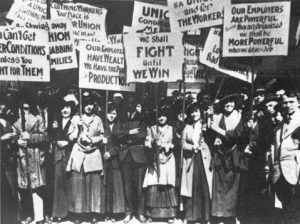 They also had families to support. Their wages were their lifeline, so they worked and worked, hoping that somehow they might create a better life for themselves and their families. These people were willing to work. All they asked for was a fair shake. Finally, they got to a point where they knew that they weren’t going to get that fair shake and they were left with no other options but to strike. It’s sad that it had to come to that point, but sometimes the strike and protest is all you have. There were other protests within the tailor industry, and many other industries too. Each one probably improved a few things, and eventually conditions got better. Of course, there will always be things to protest and people who will do so.
They also had families to support. Their wages were their lifeline, so they worked and worked, hoping that somehow they might create a better life for themselves and their families. These people were willing to work. All they asked for was a fair shake. Finally, they got to a point where they knew that they weren’t going to get that fair shake and they were left with no other options but to strike. It’s sad that it had to come to that point, but sometimes the strike and protest is all you have. There were other protests within the tailor industry, and many other industries too. Each one probably improved a few things, and eventually conditions got better. Of course, there will always be things to protest and people who will do so.

 My son-in-law, Kevin Petersen has been in our family for so long that it would be impossible to think of the family without him. Kevin started dating my daughter, Corrie when she turned 15…the age we had decided that she could date. They have been together ever since…a total of 26 years. These days it is difficult for me to imagine our family without Kevin in it. They have been married for 23 years after all. Kevin has always been a stabilizing influence in Corrie’s life. He is sensitive to her needs and emotions, and he has a way of bringing calm to her spirit. They have always looked to each other as a source of strength, humor, and happiness. They were perfect for each other from day one, and that has never changed.
My son-in-law, Kevin Petersen has been in our family for so long that it would be impossible to think of the family without him. Kevin started dating my daughter, Corrie when she turned 15…the age we had decided that she could date. They have been together ever since…a total of 26 years. These days it is difficult for me to imagine our family without Kevin in it. They have been married for 23 years after all. Kevin has always been a stabilizing influence in Corrie’s life. He is sensitive to her needs and emotions, and he has a way of bringing calm to her spirit. They have always looked to each other as a source of strength, humor, and happiness. They were perfect for each other from day one, and that has never changed.

Kevin and Corrie have two boys, Chris and Josh, and Kevin loves spending guy time with his sons. They love to go fishing, camping, and shooting. They used to love to play paintball, but these days they prefer real guns. I guess that the older the kids get the bigger and more impressive the toys become. Of course, one of the toys Kevin and the boys loved the most was the mud truck Kevin had. I guess there is nothing quite like getting down and dirty…for somebody who likes getting in the mud that is. I think I’ll pass on that sport, but Kevin really liked it. That truck sure came home muddy…ugh!! Nevertheless, times change, and mud trucking cost a lot of money. They decided to get out of it.


These days, Kevin, Corrie, and the boys spend as many weekends camping as they can possibly manage. Of course, with the boys working now, there are times when it’s just Kevin and Corrie. They love the quiet relaxation of the campgrounds. They don’t have to do anything they don’t want to. They just relax and enjoy the quiet life. As far as they are concerned, summer is for camping. Today is Kevin’s birthday. Happy birthday Kevin!! Have a great day, and a great camping weekend!! We love you!!
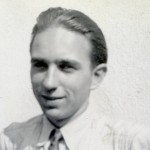
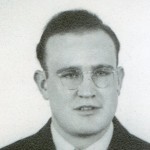 In August of 1964, my dad, Allen Spencer bought a Hollywood Reloading Press from his brother, William Spencer. Uncle Bill is two years older than my dad, and he loved his little brother, was always protective of him, and took him under his wing. As a little boy, Dad was really proud of his big brother, and wanted to say “brother” very badly, but he couldn’t quite get the word out correctly. Instead it always came out “Bowa” when Dad said it. After a while “Bowa” stuck, and the brothers both used it often. When Uncle Bill sent Dad the Reloading Press, he sent with it, a letter carefully explaining its safety instructions and its warnings. While going through Dad’s things, we came across that letter. It was such a treasure to find it, because it so perfectly depicted the relationship the brothers had.
In August of 1964, my dad, Allen Spencer bought a Hollywood Reloading Press from his brother, William Spencer. Uncle Bill is two years older than my dad, and he loved his little brother, was always protective of him, and took him under his wing. As a little boy, Dad was really proud of his big brother, and wanted to say “brother” very badly, but he couldn’t quite get the word out correctly. Instead it always came out “Bowa” when Dad said it. After a while “Bowa” stuck, and the brothers both used it often. When Uncle Bill sent Dad the Reloading Press, he sent with it, a letter carefully explaining its safety instructions and its warnings. While going through Dad’s things, we came across that letter. It was such a treasure to find it, because it so perfectly depicted the relationship the brothers had.
Always the big bowa, Uncle Bill was very excited that my dad wanted a reloading press, and since Uncle Bill was a gun dealer, who else would Dad have gone to when he wanted to make such a purchase. For those who don’t know, a Hollywood Reloading Press turns used ammunition into loaded ammunition again. Uncle Bill loved guns and all the accessories, and so it stood to reason that Dad would follow suit. The brothers had always used guns for hunting and safety, and even dynamite for blowing out tree stumps…and the occasional gate post. While boys would be boys, these boys weren’t troublemakers, but were rather careful and respected these items. They knew that improper use could be deadly. While my dad had grown up knowing about guns, Uncle Bill knew that he had not used a reloading press before, and he wanted to make sure nothing went wrong. It wasn’t that Uncle Bill thought my dad was careless, he just wanted him safe, and the reloader could bring danger, if not used correctly.
The letter, in my mind, was more about the love Uncle Bill had for my dad, than it was about the Hollywood 
 Reloading Press. Theirs was a close relationship that each of them treasured. Uncle Bill always loved writing letters. He always felt that the written documentation was forever. It carried with it the history of events that occurred in the life of the writer and the receiver. So few of us understand that, I think…at least not until it’s too late. The letter about the Hollywood Reloading Press will always be a treasure to all of my family. I’m sure that the letter was a treasure to my dad too, since he kept it all those years. And I will always think of “Bowa” when I think of the brothers now.
Reloading Press. Theirs was a close relationship that each of them treasured. Uncle Bill always loved writing letters. He always felt that the written documentation was forever. It carried with it the history of events that occurred in the life of the writer and the receiver. So few of us understand that, I think…at least not until it’s too late. The letter about the Hollywood Reloading Press will always be a treasure to all of my family. I’m sure that the letter was a treasure to my dad too, since he kept it all those years. And I will always think of “Bowa” when I think of the brothers now.
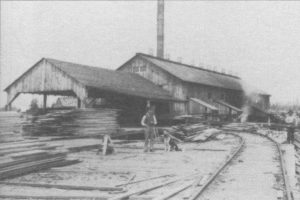
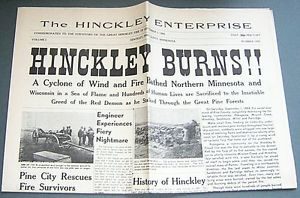 Every wildfire takes with it many victims. Humans, of course, are the most tragic, but they also take animals, homes, and plant life. When a fire gets out of control, devastation will soon follow. Often, all we think about is the loss, and that is a terrible thing, but sometimes something happens that brings a degree of victory and elation to an otherwise horrible situation. Such was the case in the September 1, 1894 Hinckley, Minnesota fire. The loss of life was devastating, with some accounts saying 440 and others saying 418…partly because the Indians weren’t counted in that amount, and partly because there were people who were never found.
Every wildfire takes with it many victims. Humans, of course, are the most tragic, but they also take animals, homes, and plant life. When a fire gets out of control, devastation will soon follow. Often, all we think about is the loss, and that is a terrible thing, but sometimes something happens that brings a degree of victory and elation to an otherwise horrible situation. Such was the case in the September 1, 1894 Hinckley, Minnesota fire. The loss of life was devastating, with some accounts saying 440 and others saying 418…partly because the Indians weren’t counted in that amount, and partly because there were people who were never found.
The upper Midwest of the United States was a wooded area, rich in timber. Hinckley was a lumber and rail town, that had been built along the Grindstone River in Minnesota near the Wisconsin border. The main industry was the lumber business, and the slash cutting technique left behind it large amounts of wood debris. The town was nicknamed The Town Built Of Wood. Little did they know what a tragic nickname that would turn out to be. The lumber yards were built quite close to the railroad tracks, and the sparks from the 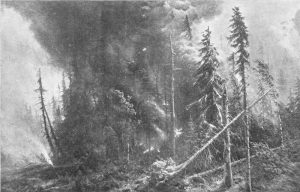 trains often set the wood debris on fire. Those fires were problematic, but no one expected the part the trains would play in 1894. That summer, a drought hit the Upper Midwest, making fires much more dangerous. The whole situation exploded on September 1, 1894, when fires near two rail lines south of Hinckley broke out, spreading north. When the raging fire reached the train depot, 350 of the residents got on a train to escape. The train passed right through flames, but reached safety in West Superior, Wisconsin. Were it not for this train, the loss of life would have been much higher. A number of the town’s residents took refuge in the swamps near town, but many of these people were killed, sadly some of them died by drowning. About 100 other residents fled to a gravel pit filled with water, and most of those people managed to survive. A train that was entering Hinckley from the north reversed direction to avoid the blaze. It still caught fire, and the only survivors were those who were able to jump from the train into a lake.
trains often set the wood debris on fire. Those fires were problematic, but no one expected the part the trains would play in 1894. That summer, a drought hit the Upper Midwest, making fires much more dangerous. The whole situation exploded on September 1, 1894, when fires near two rail lines south of Hinckley broke out, spreading north. When the raging fire reached the train depot, 350 of the residents got on a train to escape. The train passed right through flames, but reached safety in West Superior, Wisconsin. Were it not for this train, the loss of life would have been much higher. A number of the town’s residents took refuge in the swamps near town, but many of these people were killed, sadly some of them died by drowning. About 100 other residents fled to a gravel pit filled with water, and most of those people managed to survive. A train that was entering Hinckley from the north reversed direction to avoid the blaze. It still caught fire, and the only survivors were those who were able to jump from the train into a lake.
The fire burned 300,000 acres of town and forest, causing about $25 million in damages. In Hinckley, 228 people died, and another 200 in the surrounding areas, including 23 Ojibwa natives. It was a firestorm, with “as much force as an atomic bomb,” to quote a display at the town museum. Hinckley’s afternoon inferno also burned burned up five surrounding villages as it consumed over 400 square miles of kindling. It became known as the Great Hinckley Fire. A small group of statues in town represents survivors in the gravel pit. The Fire Monument and mass grave is on Fire Monument Road, very near the current interstate. Mass graves of 248 people are 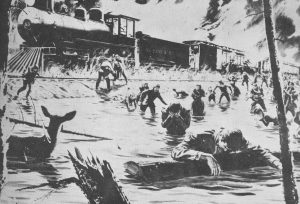
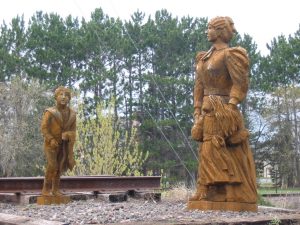 in lumpy mounds just behind the marker, dedicated in 1900 to the pioneers of civilization in Minnesota. Boston Corbett, killer of Abe Lincoln’s killer, is said to have left his “hole-in-the-ground home” in Kansas and died in the Great Hinckley Fire, in the neighboring town of Neodesha. The town of Hinckley has decided that the nickname The Town Built Of Wood is not one they want anymore, and their current slogan is “Relax…Have Fun!”
in lumpy mounds just behind the marker, dedicated in 1900 to the pioneers of civilization in Minnesota. Boston Corbett, killer of Abe Lincoln’s killer, is said to have left his “hole-in-the-ground home” in Kansas and died in the Great Hinckley Fire, in the neighboring town of Neodesha. The town of Hinckley has decided that the nickname The Town Built Of Wood is not one they want anymore, and their current slogan is “Relax…Have Fun!”

